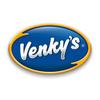Explore all the information on
Feed additives
Welcome to the page about Feed additives of Engormix; a source of knowledge on Feed additives.
The American Feed Industry Association (AFIA) has opened registration for its 50th Liquid Feed Symposium, being held Sept. 7-9, in Chicago, Ill. Attendees will network and learn about the history of legislation and regulations that affect liquid feed, the value of...
Comments : 0
Recommendations: 1
1. Introduction Starch and its derivatives are used as ingredients and it is the main component in bakery products. It is also added in low quantities as additives to improve the sensory characteristics of a large number of manufactured foods. The products resulting from the hydrolysis of starches (glucose syrup or maltose, maltodextrins) and isomerization (iso-glucose or fructose) are used in the industries of candy, sweets, chocolates, cakes, pastries, as well as in the...
Comments : 0
Recommendations: 0
Deepak Khosla, General Manager Marketing Venky´s India, speaks about a potentiated feed acidifier, Acidomix DF +, a product by Addcon which is commercialized in India. ...
Comments : 5
Recommendations: 1
The adoption of inactive dry yeast in animal feed applications across Europe will reach significant traction in the coming years. The increasing meat consumption in the region has paved the way for increased efforts towards animal health and well-being. There are also several restrictions imposed on the use of antimicrobial growth promoters across numerous countries.
Inactive dry yeast is extensively utilized solely or in combination with beneficial bacteria to produce probiotic...
Comments : 0
Recommendations: 0
Key points Due to sub-optimal selenium levels in most soils, nutritionists and scientists advocate selenium supplementation in ruminant diet. Organic selenium (selenium yeast) is more bioavailable than its mineral counterpart (selenite, selenate) for dietary supplementation, hence more effective to improve selenium status. Selenium yeast supplementation of ruminant diet has been shown to improve animal antioxidant status, reproduction, selenium...
Comments : 2
Recommendations: 0
1. F atty acids formulation: changes in nutritionists approach, questions to be answered
The aspects abovementioned are quite well-known by nutritionist, and do not constitute major concerns for them. On the contrary, nowadays lipids are not only perceived as providers of energy but also functional components of the diets with physiological and economic implications.
Due to this, nutritionists have started to consider...
Comments : 1
Recommendations: 6
The increasing household incomes of consumers across the world and their willingness to spend on food products has led to a growing intake of meat. This has given rise to consistent efforts by the livestock owners to effectively look after the health and hygiene of the animals along with the provision of functional and supplementary components in their feed. One such element that is marking its presence in animal feed is yeast as it shows immense potential in enhancing animal growth...
Comments : 0
Recommendations: 0
I. INTRODUCTION Nile Tilapia (Oreochromis niloticus) is one of the most commonly cultured freshwater fish species in Nigeria. It is a prolific breeder, widely farmed across the nations of the earth and the third largest cultured finfish [1]. Oreochromis niloticus is a native of Africa [2], considered as a standout farmed fish because of its high nutritional qualities, fast growth rate, resistance to diseases and its ability to withstand sudden environmental changes [3]. In spite...
Comments : 0
Recommendations: 1
Can you Use Guar Gum for Pellets Binders? Do you know another cheaper alternatives? ...
Comments : 2
Recommendations: 0
DESCRIPTION OF PROBLEM Creatine is a necessary component in energy metabolism, supplying phosphate groups to adenosine diphosphate and recycling them to adenosine triphosphate (ATP) that can be used for maintenance and growth. This creatine-ATP recycling system does not occur in all cells, only in those where there is great variability in energy demand, including muscle cells [1]. Creatine is especially important in growing animals such as broiler chickens, as it is not only...
Comments : 2
Recommendations: 5
Introduction The hypothalamic-pituitary-gonad axis plays an important role in regulating reproductive activities through hormonal control. Since the synthesis and secretion of androgens is the result of the activity of this axis. It is effective in creating differentiation and secondary sexual traits. Due to the high sensitivity of the reproductive process, it is important to know the factors that affect the activity of the hypothalamic-pituitary-gonad axis, and since...
Comments : 0
Recommendations: 0
INTRODUCTION The nonstarch polysaccharide (NSP) portion of corn and soybean meal (SBM) – the 2 primary ingredients in North American poultry feeds – is complex and varies considerably across both ingredients. Exogenous NSP enzymes are supplemented to improve the digestibility of this fiber fraction for which no enzymes are secreted endogenously (Bedford, 1995; Cowieson, 2010; Kiarie et al., 2013). In this regard, diets composed mainly of...
Comments : 0
Recommendations: 3
The growth graph of the global animal feed enzymes market is expected to display an upward trend in the coming years, due to the increasing preference of the people for nutritious diet along with a considerable rise in the disposable incomes, especially among the developing nations. In a report by the Government of Australia, the global consumption of meat increased to reach 360 million tons in the country by 2018.
With an evident increase in the consumption of animal by-products,...
Comments : 0
Recommendations: 1
The North America specialty animal feed additives market is projected to accrue sizable revenue growth on account of rapid expansion activities in the eggs and meat industry. Animal feed additives are preparations or substances that are added for enhancing feed quality and boosting animal nutrition.
Major regulatory organizations like the U.S. FDA are classifying animal feed additives under the Generally Recognized as Safe (GRAS) category. This makes them safe for human and animal...
Comments : 0
Recommendations: 0
The potato protein market is estimated to procure steady growth supported by robust demand for high nutritional, plant-based protein supplements. Consumers are steadily gravitating towards highly nutritious diet and are well-informed about the minimum levels of daily protein requirements. Rising environmental concerns have led people to adopt a vegan diet, which is fueling the demand for plant-based ingredients. As such, potato protein concentrate is likely to dominate the industry in the...
Comments : 1
Recommendations: 2
INTRODUCTION Seaweeds are the raw material for many industrial products like agar, alginates and carrageenan; also, they continue to be widely consumed as food and medicine in Asian countries.[1,2,3] Most edible seaweeds are known to contain significant quantities of protein, lipids, minerals, vitamins[4,5,6,7] , and nutrient contents.[8,9] Seaweeds are also considered as a source of bioactive compounds and antioxidants as they...
Comments : 0
Recommendations: 0
I. INTRODUCTION Over the last few decades, laying hen performance potential has largely been improved by genetic selection: egg production increased from 11.8 to 21.0 kg eggs per hen housed, FCR reduced from 3.29 to 1.96, mortality from 19.1 to 5.6% and body weight from 2.42 to 2.20 kg between 1970 and 2000 (Jeroch, 2011). Production cycles of 100 weeks without moulting will become commercially feasible based on improved laying persistence, although egg shell quality is still a...
Comments : 0
Recommendations: 1
Feed mixing and delivery is one of the most important activities on the dairy. Mixing and feeding a total mixed ration (TMR) is a multiple-times-per-day activity. Doing this job accurately and consistently time and time again, batch after batch and day after day is critical to production (volume and components), animal health and overall farm economics.
Accuracy and consistency of mixing and feed delivery may be one of the greatest effectors of production and feed efficiency on the...
Comments : 3
Recommendations: 6


.jpg&w=3840&q=75)





.jpg&w=3840&q=75)
















